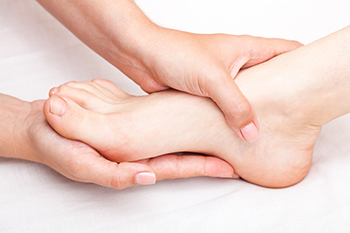Items filtered by date: April 2022
Overuse Can Cause Stress Fractures

The long bones that are found in the midfoot are referred to as the metatarsals. A stress fracture is a hairline crack in the bones, and these specific bones can be affected. This type of fracture can happen as a result of overuse, and is common among patients who enjoy running. Many people increase their running speed and mileage too quickly, and this can put extreme pressure on the bones of the feet. Additionally, excess pressure exerted on the feet may come from wearing shoes that do not fit correctly. It is important for stress fractures to be properly diagnosed, and this is generally done by having an X-ray taken. Relief can be found when the affected foot is elevated, and a cast or a boot may be worn for stability. If you have a stress fracture of the foot, it is strongly suggested that you are under the care of a podiatrist who can properly treat this condition.
Activities where too much pressure is put on the feet can cause stress fractures. To learn more, contact Dr. Joshua David Scoll from Pennsylvania. Our doctor can provide the care you need to keep your pain free and on your feet.
Dealing with Stress Fractures of the Foot and Ankle
Stress fractures occur in the foot and ankle when muscles in these areas weaken from too much or too little use. The feet and ankles then lose support when walking or running from the impact of the ground. Since there is no protection, the bones receive the full impact of each step. Stress on the feet can cause cracks to form in the bones, thus creating stress fractures.
What Are Stress Fractures?
Stress fractures occur frequently in individuals whose daily activities cause great impact on the feet and ankles. Stress factors are most common among:
- Runners
- People affected with Osteoporosis
- Tennis or basketball players
- Gymnasts
- High impact workouts
Symptoms
Pain from the fractures occur in the area of the fractures and can be constant or intermittent. It will often cause sharp or dull pain with swelling and tenderness. Engaging in any kind of activity which involves high impact will aggravate pain.
If you have any questions please feel free to contact one of our offices located in Philadelphia, Bensalem, and Fairless Hills, PA . We offer the newest diagnostic and treatment technologies for all your foot and ankle needs.
Is It Normal for My Child’s Feet to Turn Out When They Walk?
Do your child's feet turn outward when they walk? Do they walk or run awkwardly, or tend to trip or fall? Have you noticed that the soles of their shoes wear unevenly? If your child is experiencing any of these symptoms, they may be out-toeing. Some believe that out-toeing may be caused in utero, as the baby’s confined space in the womb sometimes causes their bones to twist. This may occur in the shin bones or thigh bones, or in rare cases, the hip bones. These bones usually return to a normal position on their own during the child’s first few years of life. However, this process may take longer for certain children, or may even require medical intervention if the condition worsens, causes limping or pain in the leg or hip, or if one foot turns out more than the other. If you believe your child is out-toeing, it is suggested that you make an appointment with a podiatrist who can help monitor the child’s progress, or even treat it to help correct the condition.
Making sure that your children maintain good foot health is very important as they grow. If you have any questions, contact Dr. Joshua David Scoll of Pennsylvania. Our doctor can provide the care you need to keep you pain-free and on your feet.
Keeping Children's Feet Healthy
Having healthy feet during childhood can help prevent medical problems later in life, namely in the back and legs. As children grow, their feet require different types of care. Here are some things to consider...
Although babies do not walk yet, it is still very important to take care of their feet.
Avoid putting tight shoes or socks on his or her feet.
Allow the baby to stretch and kick his or her feet to feel comfortable.
As a toddler, kids are now on the move and begin to develop differently. At this age, toddlers are getting a feel for walking, so don’t be alarmed if your toddler is unsteady or ‘walks funny’.
As your child gets older, it is important to teach them how to take care of their feet.
Show them proper hygiene to prevent infections such as fungus.
Be watchful for any pain or injury.
Have all injuries checked by a doctor as soon as possible.
Comfortable, protective shoes should always be worn, especially at play.
If you have any questions please feel free to contact one of our offices located in Philadelphia, Bensalem, and Fairless Hills, PA . We offer the newest diagnostic and treatment technologies for all your foot and ankle needs.
It's Time for Beautiful Feet
What Might Be Causing Your Child’s Heel Pain
Active, growing children that experience pain in their heels may have a condition known as Sever’s disease. The cause of this pain stems from irritation of the growth plate in the heel bone, as it has not yet completely developed and calcified. Bones in the calf grow more rapidly than the Achilles tendon, which attaches to the heel bone where the growth plate is located. This difference in growth can cause tightness and pressure in the Achilles tendon, which is often exacerbated with physical activity—particularly sports that involve running and jumping. Icing the area and refraining from activities that make the pain worse can sometimes help ease the pain. For professional pain relief, make an appointment with a podiatrist. They can offer a variety of pain management techniques, such as custom orthotics and heel raises, personalized stretching routines, footwear recommendations, and prescription pain medications.
Sever's disease often occurs in children and teens. If your child is experiencing foot or ankle pain, see Dr. Joshua David Scoll from Pennsylvania. Our doctor can treat your child’s foot and ankle needs.
Sever’s Disease
Sever’s disease is also known as calcaneal apophysitis, which is a medical condition that causes heel pain I none or both feet. The disease is known to affect children between the ages of 8 and 14.
Sever’s disease occurs when part of the child’s heel known as the growth plate (calcaneal epiphysis) is attached to the Achilles tendon. This area can suffer injury when the muscles and tendons of the growing foot do not keep pace with bone growth. Therefore, the constant pain which one experiences at the back of the heel will make the child unable to put any weight on the heel. The child is then forced to walk on their toes.
Symptoms
Acute pain – Pain associated with Sever’s disease is usually felt in the heel when the child engages in physical activity such as walking, jumping and or running.
Highly active – Children who are very active are among the most susceptible in experiencing Sever’s disease, because of the stress and tension placed on their feet.
If you have any questions, please feel free to contact one of our offices located in Philadelphia, Bensalem, and Fairless Hills, PA . We offer the newest diagnostic and treatment technologies for all your foot and ankle injuries.
The Difference Between Strains and Sprains
Anyone who is active in sports or running is probably familiar with foot and ankle pain, the most common of which are strains and sprains. A strain affects a muscle or tendon, which is the tissue that attaches the muscle to a bone. A sprain, however, affects a ligament, which is the band of tissue that actually holds the muscle to the bone. Strains and sprains have similar symptoms, including pain, swelling, bruising, and weakness when you move the injured body part. The main differences between them are how the injury occurs, how serious it is, and how long it may take to recover. A strain, sometimes called a pulled muscle, is more likely to occur when a person doesn’t warm up before the activity, returns to an activity after time off, or continues an activity when their muscles are tired. The muscle or tendon is stretched too far, but will probably heal in a couple of weeks. A sprain is generally the result of twisting a joint, such as an ankle, or landing wrong on the foot from a jump. The ligament is stretched or torn, and is more likely to take between four to six weeks to heal, possibly longer. If you have injured your foot or ankle during an exercise, it is wise to see a podiatrist as soon as possible for a proper diagnosis and options for treatment.
Sports related foot and ankle injuries require proper treatment before players can go back to their regular routines. For more information, contact Dr. Joshua David Scoll of Pennsylvania. Our doctor can provide the care you need to keep you pain-free and on your feet.
Sports Related Foot and Ankle Injuries
Foot and ankle injuries are a common occurrence when it comes to athletes of any sport. While many athletes dismiss the initial aches and pains, the truth is that ignoring potential foot and ankle injuries can lead to serious problems. As athletes continue to place pressure and strain the area further, a mild injury can turn into something as serious as a rupture and may lead to a permanent disability. There are many factors that contribute to sports related foot and ankle injuries, which include failure to warm up properly, not providing support or wearing bad footwear. Common injuries and conditions athletes face, including:
- Plantar Fasciitis
- Plantar Fasciosis
- Achilles Tendinitis
- Achilles Tendon Rupture
- Ankle Sprains
Sports related injuries are commonly treated using the RICE method. This includes rest, applying ice to the injured area, compression and elevating the ankle. More serious sprains and injuries may require surgery, which could include arthroscopic and reconstructive surgery. Rehabilitation and therapy may also be required in order to get any recovering athlete to become fully functional again. Any unusual aches and pains an athlete sustains must be evaluated by a licensed, reputable medical professional.
If you have any questions please feel free to contact one of our offices located in Philadelphia, Bensalem, and Fairless Hills, PA . We offer the newest diagnostic and treatment technologies for all your foot and ankle needs.




